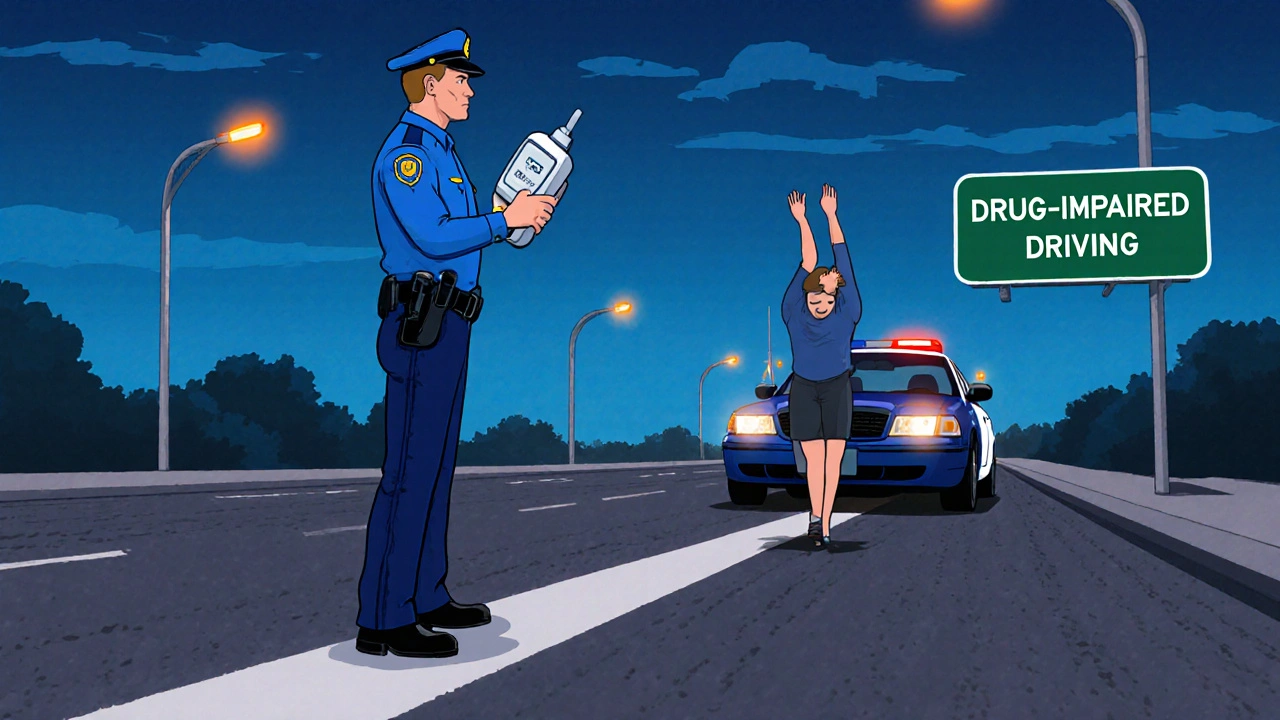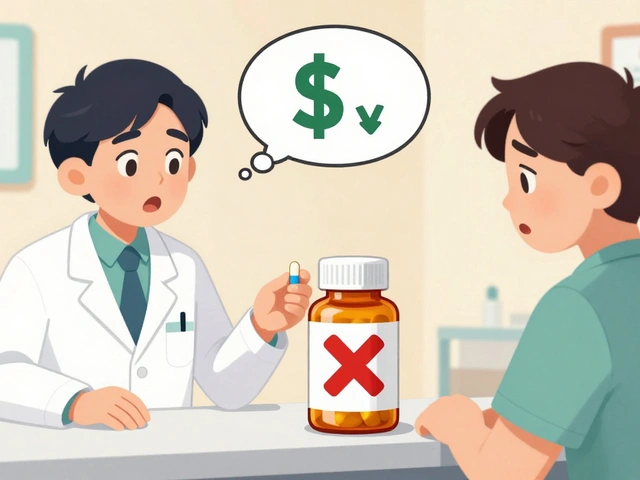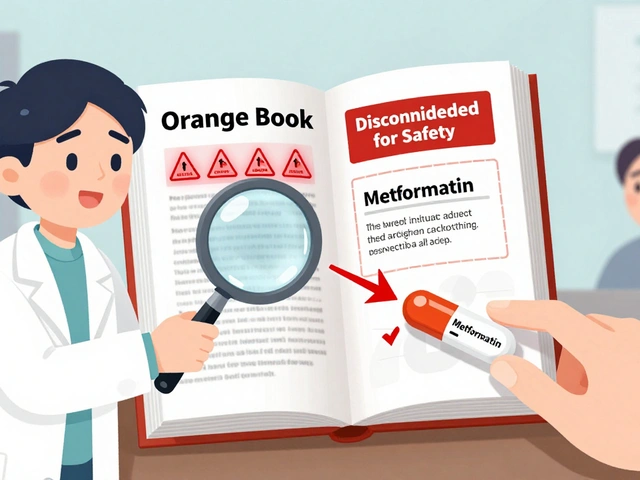Opioid-Impaired Driving: Laws, Risks & Safe Practices

Opioid Driving Safety Calculator
Opioid Driving Safety Calculator
Enter your opioid type to calculate safe waiting time before driving and understand legal implications.
Key Takeaways
- Opioids can double your crash risk by causing drowsiness and poor judgment.
- All U.S. states and Canada treat opioid‑related driving impairment as a criminal offense, but enforcement rules differ.
- Zero‑tolerance and per se laws mean any detectable amount can lead to a DUI, even if you have a valid prescription.
- Standardized Field Sobriety Tests and oral‑fluid screens are the main tools police use, yet exact blood‑level limits for opioids remain undefined.
- Plan ahead: wait 3‑4 hours after immediate‑release opioids (6‑8 hours for extended‑release) and arrange a sober ride.
Driving while on opioids isn’t just a personal health decision-it’s a legal landmine. Whether you’re taking a prescription painkiller after surgery or have used an illicit opioid, the drug can impair the cognitive and motor skills needed for safe driving. In the United States, every state has some form of impaired‑driving law that covers opioids, and Canada applies the same penalties as for alcohol. This guide walks you through how opioids affect driving, what the law says, how police detect impairment, and concrete steps you can take to stay safe on the road.
How Opioids Change the Way You Drive
Opioid‑impaired driving is the act of operating a motor vehicle while under the influence of opioid medications or illegal opioids, which reduces alertness, slows reaction time, and clouds judgment. The National Institute on Drug Abuse (NIDA) explains that opioids commonly cause drowsiness, dizziness, and impaired cognitive functioning. A 2023 NIDA DrugFacts report found that driving under opioid influence can double the risk of a crash compared with sober driving.
These effects differ from alcohol in two key ways. First, opioids often produce profound drowsiness without obvious slurred speech or obvious odor, making it harder for officers to spot impairment. Second, the relationship between blood concentration and functional impairment is less clear for opioids, so the legal threshold is not as straightforward as the 0.08 % BAC standard used for alcohol.
Legal Landscape in the United States
All 50 states, the District of Columbia, and several territories have statutes that criminalize drug‑impaired driving. However, the approach varies:
- Zero‑tolerance laws - 16 states (including California, New York, and Texas) treat any detectable amount of a specified drug as a violation, regardless of actual impairment.
- Per se laws - 5 states (e.g., Ohio, Pennsylvania) have set legal limits for particular drugs. For opioids, the limits are still being debated.
- Impairment‑based standards - The majority of states rely on observable impairment, using Standardized Field Sobriety Tests (SFST) and the Drug Evaluation and Classification (DEC) program to determine if a driver is under the influence.
Prescription‑use defenses differ widely. Georgia allows a “therapeutically appropriate” defense for drivers under 21, Utah permits a defense if the opioid was prescribed, and Wisconsin requires a preponderance‑of‑evidence showing a valid prescription. The American Civil Liberties Union warned in 2021 that these defenses can be unevenly applied, sometimes criminalizing patients who are following a doctor’s orders.

Canada’s Uniform Approach
Canada treats opioid‑related driving impairment under the Criminal Code the same way as alcohol impairment. A driver found with any detectable opioid in their system can face the same penalties as a driver with a BAC over 0.08 %. The Canadian Centre on Substance Abuse (CCSA) notes that youth are especially vulnerable because they combine inexperience with the sedative effects of opioids.
How Law Enforcement Detects Opioid Impairment
Police typically start with the Standardized Field Sobriety Tests-walking‑the‑line, one‑leg stand, and horizontal gaze nystagmus. If the officer suspects drug use, the DEC program guides a more detailed evaluation, which may culminate in a blood, urine, or oral‑fluid sample.
Since 2020, oral‑fluid devices such as the Dräger DrugTest 5000 have been approved by the FDA for roadside screening of fentanyl and other synthetic opioids. By 2023, 47 U.S. states used oral‑fluid testing, up from 32 in 2020. However, these devices can confirm presence, not impairment level, leaving courts to interpret the results.
Because there is no universally accepted blood‑concentration threshold for opioids, courts often rely on expert testimony to link a detected amount to functional impairment. This legal gray area means that even trace amounts can lead to a DUI conviction under zero‑tolerance statutes.
Practical Steps to Stay Safe
If you’re prescribed opioids, follow these evidence‑based recommendations to reduce crash risk and stay on the right side of the law:
- Ask your prescriber how the specific opioid affects driving. Immediate‑release formulations (e.g., oxycodone) typically require a 3‑4 hour waiting period before driving; extended‑release (e.g., methadone) may need 6‑8 hours.
- Plan alternate transportation before you take your dose. A sober friend, ride‑share app, or public transit can eliminate the need to drive while impaired.
- Never combine opioids with alcohol or sedating benzodiazepines. Polysubstance use dramatically raises crash risk.
- Read the medication guide carefully. Since 2020 the FDA mandates a "Do Not Drive" warning on all opioid medication guides.
- If you feel drowsy, pull over safely or wait until the effects wear off. The National Safety Council found that 72 % of patients never receive adequate counseling about driving risks.
These steps are echoed by the California Office of Traffic Safety, which campaigns for “Plan Ahead, Drive Sober” and stresses seat‑belt use as the best defense against injury when an impaired driver is on the road.

Future Directions: Law, Technology, and Public Health
Legislators are moving toward more standardized limits. The Transportation Research Board’s 2023 consensus report recommends scientifically validated per se limits for major drug categories-including opioids-within five years. Seven states are currently considering per se limits specifically for opioids, building on the five states that already have them.
Funding for enforcement is rising. The National Highway Traffic Safety Administration (NHTSA) allocated $15.7 million in 2023 for drug‑impaired driving programs, a 22 % increase from 2021. The agency’s Drug‑Impaired Driving Initiative also aims to train 5,000 additional Drug Recognition Experts by 2025.
Technology will play a bigger role. Oral‑fluid screening devices are expected to become standard equipment for police stops, and research into wearable sensors that detect sedation is ongoing. These tools could eventually provide real‑time impairment data, narrowing the gap between detection and legal thresholds.
On the medical side, pharmaceutical companies must now include stronger “Do Not Drive” warnings as part of FDA‑mandated Risk Evaluation and Mitigation Strategies (REMS). Some insurers are also beginning to require medication reviews for drivers who hold commercial licenses.
What to Do If You’re Charged with an Opioid‑Related DUI
Facing a DUI on opioids can be daunting, especially if you were following a prescription. Here are immediate steps to protect your rights:
- Secure legal representation with experience in drug‑impaired driving cases.
- Obtain a copy of your prescription records and any doctor’s notes indicating dosage and timing.
- Request a thorough drug‑testing report, including the method used (blood vs. oral‑fluid) and the detection limits.
- Consider a forensic toxicology expert to interpret whether the detected level could have caused impairment.
- Explore diversion programs or medication‑management counseling, which many courts view favorably.
Remember that a DUI can affect your license, insurance rates, and employment-particularly if you drive for work. Early action and proper documentation can mitigate long‑term consequences.
Bottom Line
Opioids are powerful pain relievers, but they also compromise the mental sharpness needed for safe driving. The law is catching up, with zero‑tolerance and per se statutes making any detectable amount a potential criminal offense. By understanding how opioids affect you, staying informed about local regulations, and planning safe alternatives, you can protect yourself, other road users, and your legal standing.
Can I drive after taking a prescribed opioid?
Yes, but only after waiting the recommended time-usually 3‑4 hours for immediate‑release pills and 6‑8 hours for extended‑release formulations. Check with your prescriber and consider a sober ride if you feel any drowsiness.
What are zero‑tolerance laws?
Zero‑tolerance laws make any detectable amount of a specified drug, including opioids, a criminal offense, even if you are not visibly impaired. Sixteen U.S. states have such statutes.
How do police test for opioids on the road?
Officers start with field‑sobriety tests. If they suspect drug use, they may use oral‑fluid devices like the Dräger DrugTest 5000 or request a blood/urine sample for laboratory analysis.
What should I do if I get a DUI for opioids?
Hire an attorney experienced in drug‑impaired cases, gather your prescription records, request the full toxicology report, and consider a forensic expert to interpret the results. Early action can help reduce penalties.
Are there any safe‑driving guidelines for chronic pain patients?
The Mayo Clinic advises waiting at least 3‑4 hours after an immediate‑release opioid dose and 6‑8 hours after an extended‑release dose before driving. Always arrange a sober ride if you’re unsure.
12 Comments
Miracle Zona Ikhlas
Plan your ride before the dose hits – a quick call or rideshare keeps you safe and your record clean.
naoki doe
Law enforcement has been pushing oral‑fluid devices faster than the science can keep up. The Dräger DrugTest 5000 can flag fentanyl at parts‑per‑billion, but it still can’t tell you how impaired you actually are. Many officers treat a positive screen as proof of guilt, sidestepping the usual field‑sobriety observations. The lack of a clear per‑se limit means courts are left to guess whether the amount matters. As a result, drivers end up fighting a legal battle that feels more like a guessing game than a fair trial.
Holly Kress
Prescription defenses vary wildly across states, which can leave patients in a legal limbo. In Georgia, a doctor’s note can shield drivers under 21, while Wisconsin demands a preponderance of evidence that the medication was taken as directed. Some jurisdictions even require the medication to be taken within a specific window before the stop. This patchwork makes it hard for clinicians to give consistent advice. It also opens the door for selective enforcement, especially in communities already over‑policed. Knowing your state’s exact wording can be the difference between a warning and a charge.
Chris L
When you’re on pain meds, think of the road as a shared space that deserves your full attention. Even a small dip in reaction time can turn a routine commute into a nightmare. Arrange a backup plan – a friend, a taxi, or a scheduled ride‑share – before you pop the pill. If you ever feel drowsy, pull over safely and wait it out; the extra minutes are worth the peace of mind. Staying proactive protects you, your loved ones, and keeps your driving record spotless.
Gary Campbell
Ever notice how the rollout of oral‑fluid tests coincided with an uptick in opioid‑related arrests? Some argue it’s a coordinated push to criminalize patients who truly need pain relief. The devices can detect trace amounts that are unlikely to impair, yet the law treats any presence as guilt. This creates a perfect storm where law‑enforcement gains more leverage without solid scientific backing. It’s worth questioning whether the solution is safety or simply a new revenue stream for the justice system.
Barna Buxbaum
Oral‑fluid screening has become the go‑to field method because it’s quick, non‑invasive, and can flag synthetic opioids like fentanyl. The FDA cleared the Dräger DrugTest 5000 in 2020, and by 2023 most states had adopted it. However, the test only reports presence, not concentration, so a positive result doesn’t automatically prove impairment. Officers usually pair the screen with Standardized Field Sobriety Tests to build a case. If the driver fails those tests, the lab‑confirmed presence can solidify a DUI charge. Until per‑se limits are set, the legal interpretation will stay in a gray area.
Alisha Cervone
Just another reminder to read the label.
Diana Jones
Oh great, another “Do Not Drive” warning buried in fine print – because we all love a good treasure hunt before a surgery. The pharma lingo sounds reassuring, yet it’s basically a legal disclaimer that you’ll ignore the moment you’re in pain. If you’re already juggling oxycodone and a deadline, who has time to decode the pharmacokinetic jargon? Bottom line: the warning exists, the risk is real, and trucking yourself to the pharmacy while drowsy is a bad idea. So maybe schedule that Uber before the pill hits the bloodstream.
asha aurell
The fear‑mongering narrative you push only fuels stigma and distracts from real solutions.
Abbey Travis
You raise solid points about the technology gap, and it’s encouraging to see more clinicians advocating for clear guidelines. Helping patients navigate these murky waters starts with transparent conversation.
Joy Dua
The current legal apparatus treats opioid detection as a binary switch – present equals culpable, absent equals innocent – a reductionist view that ignores pharmacodynamics. By painting every trace of morphine as a criminal act, the system indulges in an ethical myopia that jeopardizes patient autonomy. Such overreach resembles a witch hunt, where the mere scent of a substance triggers punitive measures regardless of functional impairment. A forensic toxicologist, armed with dose‑response data, could untangle this mess, yet courts rarely grant them that authority. Until the law embraces nuance, the narrative will remain a caricature of justice.
Charlene Gabriel
Driving under the influence of opioids is more than a textbook warning; it’s a lived reality for countless patients who juggle pain management and everyday responsibilities. When an immediate‑release pill hits the bloodstream, the sedative effect can manifest within 30 minutes, turning a routine drive into a high‑risk maneuver. Extended‑release formulations linger longer, extending drowsiness well into the afternoon, which many users underestimate. The statistics are stark: a 2023 NIDA report showed that opioid‑impaired drivers are twice as likely to be involved in a crash compared to sober drivers. Yet, many state laws still rely on subjective field‑sobriety tests that were originally designed for alcohol. This mismatch creates a legal gray area where a driver may be flagged for a positive test even if they feel perfectly capable behind the wheel. Moreover, zero‑tolerance statutes in sixteen states mean that any detectable amount, no matter how minuscule, can trigger a DUI charge. The per‑se limits that exist for some drugs are still under debate for opioids, leaving law‑enforcement to interpret ambiguous data. Police departments have increasingly turned to oral‑fluid devices, which can detect trace levels, but they cannot quantify impairment. As a result, courts often rely on expert testimony to bridge the scientific gap, turning every case into a costly courtroom battle. For drivers with legitimate prescriptions, the dilemma intensifies: obey the law or risk a penalty while managing chronic pain. The solution begins with proactive planning – scheduling rides, coordinating with family, and adhering to the recommended waiting periods of three to four hours for immediate‑release and six to eight hours for extended‑release medications. Healthcare providers also bear responsibility by counseling patients explicitly about driving risks and emphasizing the “Do Not Drive” warnings that now appear on every label. Public health campaigns can reinforce these messages, targeting not just patients but also families who can offer safe transportation alternatives. Finally, legislators must work toward scientifically validated per‑se thresholds that reflect true impairment, eliminating the current reliance on presence‑only laws. By aligning medical guidance, law enforcement practice, and legislative clarity, we can reduce the tragic toll of opioid‑related crashes while respecting the needs of those who rely on these medications for pain relief.






Write a comment